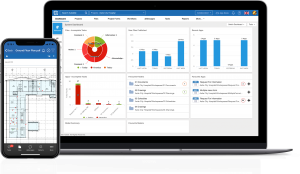Industry 4.0: Weaving the Thread With Digital Twins

A new report released by Asite highlights the importance of digital twins across all sectors, including manufacturing, health and housing. Quadrant Smart analyses the ‘Digital Twin: Weaving the Golden Thread’ report, to reveal the foundations required for wide-scale implementation of digital twins as we head towards Industry 4.0.
Undoubtedly, digital twins are set to usher in a new and exciting digital era. To ensure this technological push is as successful as possible, Asite has published a report to examine the ways to build digital twins.
Asite’s open construction platform enables organizations working on capital projects to come together, plan, design, and build with seamless information sharing across the entire supply chain.

Nathan Doughty, CEO Asite
With the main focus on the idea of the golden thread of information. The report states: “A digital twin relies on sensor data from its physical counterpart and includes a combination of metadata, event data, and analytics. To enhance insights, improve performance, and optimize decision making, a digital twin needs lots of rich, diverse, and reliable asset-related data.”
Additionally, the report focuses on three core principles, which are:
- 75% of companies from various industries across six countries have already implemented or plan to implement a digital twin within a year.
- Openness, collaboration, and interoperability need to be embraced to optimize the implementation of digital twin technology.
- A global digital framework could help industries overcome the challenges currently inhibiting digital twins.
Trans-national support for digital twins
As shown above, three-quarters of companies from many different industries have already implemented or plan to implement a digital twin within a year. This proves there is a massive swell of support for using digital twins to improve services across the country and even further than that.
Despite this multidisciplinary support, data fragmentation is a huge obstacle for the golden thread of information. Digital twins work best when there is a seamless flow of data from the beginning of the project throughout its life cycle and beyond.
Fragmentation and lack of robust methods of data exchange have resulted in data being utilized poorly. Through this, insights can be routinely lost which leads to deployed solutions not being optimized.
Nathan Doughty, CEO of Asite explained: “In fluctuating and increasingly uncertain times, digital twins can provide the built environment with a level of predictability and certainty that we need to remain resilient.”
Digital fragmentation a solvable issue
Quadrant Smart was told to tackle digital fragmentation: “Digital twin technology needs to realise its potential. We need a common open platform that will allow us to send, receive, capture, store, and share structured and unstructured data. This will help us to collaborate without barriers – and specifically, without vendor lock-in or proprietary software.”
The Asite Platform connects a growing ecosystem of partners through standardized interfaces, consolidating strengths to unlock everything digital twins have to offer.
In addition to openness and collaboration, the report also explains that developing a global digital framework will aid in overcoming challenges currently facing digital twins.
Digital twin technology needs to realise its potential. We need a common open platform that will allow us to send, receive, capture, store, and share structured and unstructured data
“Establishing how data is used, maintained, and shared would allow us freely share and interpret data and insights, creating an accurate record of a project and providing the optimal conditions for digital twins to thrive,” added Nathan.
Furthermore, the snapshot report looks at the deployment and potential capabilities of digital twins across traditional industries.

The Asite platform
This includes city planners, who have become early adopters of digital twin technology using virtual models to gain a competitive edge; retailers, who are using digital twins to create customer personas, thereby enhancing services and improving product offerings.
Housing is also an area of interest as it can be used to make smarter and more sustainable decisions for our communities to deliver better quality homes. In the manufacturing sector, where the technology holds the most compelling promise with digital twins set to impact the way products are designed, manufactured, and maintained.
This technology is not only capable of providing valuable insight into infrastructure but also on a human level. The use in healthcare could be the creation of a digital replica of a patient, which can then be used by surgeons and health professionals to practice procedures in a simulated environment.
What is clear, is that as we move towards industry 4.0, solving these challenges at the early stages of digital twins, will improve the rollout and success of technology to improve multiple aspects of human life, behaviour and infrastructure.

